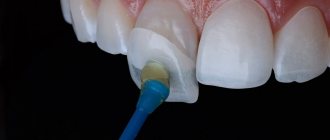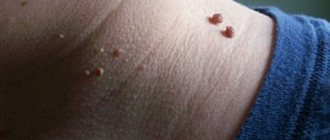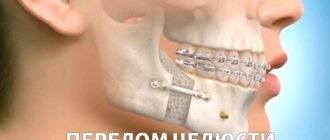21.11.2019
A filled tooth may not bother a person for a long time, not change its appearance and not show any signs of destruction. However, fillings do not always last for many years and protect teeth from pathological changes. The first sign of destructive processes is darkening of the enamel. What to do if a tooth under a filling turns black? What are the reasons for this phenomenon, and what steps should be taken to avoid losing the tooth altogether?
Additional symptoms
Typically, the appearance of secondary caries is accompanied not only by darkening, but also by a number of other symptoms that are difficult to miss. What should you pay attention to if your teeth turn black? Let's consider additional symptoms:
- change in enamel color, appearance of a black dot on the surface, darkening and other visual signs of destruction;
- bad breath, especially in the morning after waking up, is the result of the development of pathogens and tissue destruction;
- mobility of the filling, which may eventually partially crumble or fall out completely;
- pain, especially if the nerves are not removed;
- redness of the gums caused by the presence of an inflammatory process.
Even if the blackening of the filling is not accompanied by the additional symptoms described above, it is recommended to undergo a preventive examination so that a specialist can identify the causes of the problem and determine the tactics for further action.
Reasons for color change
Have you noticed that the filling on your tooth has darkened? Several factors could have contributed to the color change.
- Consumption of coloring products. A newly placed filling can become darkened by strong tea, black coffee, chocolate, red wine, grapes, and concentrated fruit juices. The composite can also become colored when consuming carrots, beets, blueberries, cherries, and carbonated drinks with dyes.
- Smoking. Tobacco smoke causes resins, plant alkaloids, and organic acids to settle on restored teeth, causing them to acquire a yellowish or brown tint.
- High levels of fluoride in water and food. Drinking low-quality water and foods high in mineral content can cause multiple stains on your teeth.
- Insufficient oral hygiene. If you don't clean your teeth well, stains will remain on them and bacterial plaque will accumulate. This can lead to secondary caries.
Diagnostics
The task of diagnosis is to determine why the filling material and the dental elements underneath have turned black. Professional techniques will help identify the presence of caries and the extent of damage in order to make a final decision on removal or treatment.
Diagnosis consists of a visual examination, as well as an x-ray examination. If concomitant diseases of the oral cavity are suspected, additional diagnostic methods can be used.
What to do if the filling is evenly colored
If, some time after treatment and filling of a tooth, you suddenly discover that the filling has changed color - it has become pinkish or yellowish, or simply darkened - in most cases this means one thing: you forgot about the doctor’s instructions and still ate some kind of coloring eating too early. A newly installed filling, unfortunately, is susceptible to staining, and if you dined on something with a high content of dyes, it may change color.
How to fix:
Contact a dentist who will polish and clean the filling. Most often, the top stained layer will be sanded and the filling will become lighter again.
In addition, old fillings can also become stained, but for a different reason. Modern fillings are made from a composite material that is most suitable for dental purposes in composition and function. It has only one drawback: due to frequent temperature changes (consumption of hot and cold food), this material expands and contracts again. These are microscopic changes, we don’t feel or see them, but microbes and dyes can still get inside the filling this way.
How to fix:
The dentist, depending on the situation, will suggest either replacing the filling (if it is very old and no longer performs basic functions), or will be able to polish it. But replacement is a more suitable option.
Therapy
If the filling on the front tooth or on any other tooth has darkened, there are three possible solutions to the problem, the choice of which should be determined by the diagnostic results:
- Removal: performed if the tooth is so damaged that it cannot be cured;
- Removing an old filling, treating caries and installing a new filling material;
- Installation of a dental crown after complete elimination of the pathology.
If complications develop and other diseases occur, additional therapeutic measures may be required to eliminate the source of infection and restore the tooth.
Treatment methods in dentistry
If your teeth begin to darken, you should not ignore the problem. A visit to the dentist will be the best decision. The specialist will conduct an examination and diagnosis, based on the results of which he will determine the cause of the change in the color of the dental crown. The method of restoring the shade of the enamel will directly depend on the provoking factor.
For pathological internal processes, treatment is carried out:
- caries removal and tooth restoration;
- removal of the old filling and re-sealing;
- replacement of a metal inlay or artificial crown with a metal-free structure;
- tooth restoration after injury;
- and other methods.
If the teeth are healthy and the reason for their darkening is external influences, then the following is carried out:
- professional teeth cleaning to remove plaque and tartar;
- teeth whitening using gentle and safe methods;
- remineralization of enamel and crown to increase resistance to dyes.
You should not resort to self-medication at home. When the enamel darkens, the dental tissue is weakened and any unprofessional methods of exposure can provoke complications of the underlying disease or the development of pathological processes.
Prevention
You can prevent blackening of a tooth under a filling with the help of effective prophylaxis. To avoid the need for re-treatment, you should follow several rules:
Firstly, follow all the hygiene instructions of doctors - brush your teeth in a timely and regular manner, using the right toothpaste, floss, and rinses. Secondly, undergo preventive examinations in a timely manner in order to identify and treat any diseases in the early stages, before complications arise.
Try to avoid temperature changes - do not eat hot and cold food at the same time, do not drink hot drinks in the cold. Avoid traumatic effects - do not gnaw hard food (nuts, seeds) with filled teeth. Treat any infectious diseases in a timely manner, including those that are not directly related to the oral cavity.
Get rid of bad habits that disrupt the body’s activities and weaken its protective functions. Do not skimp on tooth restoration and, if the filling has darkened, replace it in a timely manner.
Causes of darkening of teeth
The condition of teeth is a reflection of nutrition, care, bad habits and other factors. If your teeth begin to darken, you need to consider a variety of reasons that could cause a change in the shade of the enamel. All the reasons why tooth enamel is darker are divided into external and internal.
External reasons
External causes mean processes occurring due to external influences on the teeth.
- Poor hygiene. Due to insufficient quality dental care, plaque remains on the enamel. Gradually, the deposits begin to compact and become more dense. If the plaque is exposed to dye, its pigment penetrates deep into the dense structure.
- Dyes. Tooth enamel weakened due to demineralization or bleaching becomes unstable to artificial and natural dyes. Changes in the color of teeth can occur with frequent consumption of foods with dyes (coffee, bright berries, vegetables and fruits, carbonated and alcoholic drinks, sweets, spices, etc.).
- Smoking. Black teeth are a common problem among smokers. The resins released when smoking a cigarette into the oral cavity are abundantly deposited on the enamel and adhere tightly to it.
Black plaque on teeth cannot be removed with a toothbrush or even whitening toothpaste. An aesthetic defect can only be eliminated using professional dental methods.
Internal reasons
External factors provoke mainly an aesthetic defect, but can cause an increased risk of dental diseases. Internal causes should be taken as seriously as possible, since they involve the impact of pathological processes on the teeth, which will only progress without appropriate treatment.
Internal factors that cause teeth to darken.
- Caries. The most common cause of darkening of tooth enamel. A distinctive feature is the change in color of one tooth. In rare cases, several adjacent teeth darken. Tooth decay can appear as a spot or cavity. If the cervical form of caries occurs, then the roots of the teeth darken, or more correctly, the root zone.
- Seal. Black teeth may be the result of fillings. Some types of composite contain substances that stain the dentin and crown. Modern dentistry does not use such materials, but if the tooth was filled more than 7-10 years ago, similar reasons cannot be ruled out.
- Metal insert. Metal is prone to oxidation, which can easily cause tooth enamel to darken.
- Metal crowns. The installation of classic metal crowns has such a defect as darkening of the tooth in the area of the marginal gum line. The appearance of blackness indicates an oxidation process, which causes the metal to be exposed to the acidic environment of the oral cavity.
- Injuries. The tooth is equipped with a large number of blood vessels, if damaged, blood can penetrate into the dentin. Due to the accumulation of blood under the crown, the process of breakdown of blood particles will affect the color of the tooth, which will change from red to blue-black.
- Depulpation. Removing the dental nerve entails many consequences. Including darkening of the enamel. The reason is a lack of nutrition to the tooth or the development of recurrent caries.
With the progression of internal causes, treatment is a mandatory step in restoring dental health and aesthetics. Depending on the pathology, the specialist determines ways to influence the pathological process.
Tooth hurts under filling
You are here: Dental clinic > Questions and answers > A tooth hurts under a filling
The final stage in the treatment of caries, pulpitis and some other dental diseases is filling. But what if after this the tooth under the filling hurts? First, we should consider the main causes of this condition.
- Secondary (recurrent) caries under a filling. A carious cavity appears next to the applied filling. The cause of this condition is incomplete removal of softened dentin (the main tooth tissue) in the carious cavity during treatment. Caries developing under a filling is also the answer to the question of why a tooth turns black. The appearance of a dark spot around the filling is an early diagnostic symptom. You should not wait for the onset of pain; a change in the color of the tooth tissue near the filling is already an indication for contacting a dentist.
- Pulpitis under the filling. If the root canals are not widened enough or have curvatures, it is difficult to remove the pulp. In addition, an error may occur at the stage of canal filling. That is why in “Calypso”, Yekaterinburg, X-ray control is used in the treatment of pulpitis - the cost of an error is too high.
- Incomplete removal of nerve tissue. If your dead tooth hurts, this indicates that the nerve or infected tissue around it has not been completely removed.
- Increased sensitivity of teeth, which can be subjectively regarded as pain. The pain intensifies when chewing solid food. Reasons: Before applying the adhesive material, the dental cavity must be dried with a jet of air. If the doctor overdries or does not dry out the formed cavity, then irritation of the nerve endings in the dentin occurs, causing pain.
- Pulp necrosis. After filling with silicate cement or one of the composite materials, acute pain may occur as a result of violation of the application of the insulating lining. The filling material irritates the pulp, causing inflammation or necrosis.
Thus, even with a superficial examination of the reasons, it becomes clear that in 99% of cases where a tooth hurts under a filling, there are medical errors. Calypso specialists recommend treating the tooth in private dentistry, using modern technical equipment and materials. If pain occurs after filling a tooth or the pain persists for more than two days, consult a dentist immediately!









